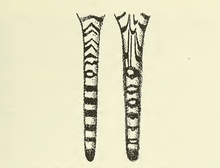Tiger tail

A tiger tail is part of the morphology of a tiger.
Biology
The natural pattern of the colouration of a tiger's tail depends largely on the subspecies. The extinct Caspian tiger had less developed angular patterns at the base of its tail than subspecies of the Far East.[1] Tail length also varies between subspecies. The tails of Bengal tigers are shorter than those of Siberian tigers,[2] which, in fully grown males, are about 1 m (39 in) in length.[3] Tigers have a variety of uses for their tails. When jumping, they use their tails as rudders. Their tails help them balance when they are climbing. Tigers also use their tails to communicate with each other.[4] An upright, slowly wagging tail indicates friendliness, while an outstretched, quickly wagging tail indicates excitement, and a tail that is barely moving and angled towards the ground indicates tenseness.[5]
In human culture
In traditional Chinese medicine, tiger tails are used to treat cutaneous conditions[6] and rheumatism.[7] In 19th-century Korea, a military unit serving under Heungseon Daewongun wielded spears around which they tied tiger tails.[8] Korean proverbs include "If you tread on the tail of a tiger, you'll know it," and "It is hard to let go the tail of a tiger."[9] The idea of treading on the tail of a tiger is common in East Asia, and is often used to refer to a hazardous situation.[10]
References
- ↑ Geptner, V.G., Sludskii, A. A. (1972). Mlekopitaiuščie Sovetskogo Soiuza. Vysšaia Škola, Moskva. (In Russian; English translation: Heptner, V.G., Sludskii, A.A., Bannikov, A.G. (1992). Mammals of the Soviet Union. Volume II, Part 2: Carnivora (Hyaenas and Cats). Smithsonian Institution and the National Science Foundation, Washington DC). Pages 95–202.
- ↑ Kerley, L.; Goodrich, J.; Smirnov, E.; Miquelle, D.; Nikolaev, I; Arjanova, T.; Slaght, J.; Schleyer, B.; Kuigli, H.; Hornoker, M. 2005. Chapter 7. Morphological indicators of the Amur tiger. 15 pp. In D.G. Miquelle, E.N. Smirnov, and J.M. Goodrich (Eds.). Tigers in Sikhote-Alin Zapovednik: Ecology and Conservation. PSP, Vladivostok, Russia (Russian) Translate.google.com
- ↑ Mazák, V.: (1983) Der Tiger. Nachdruck der 3. Auflage von Westarp Wissenschaften Hohenwarsleben, 2004. ISBN 3-89432-759-6
- ↑ Sigmund A. Lavine (1987). Wonders of Tigers. Dodd, Mead and Company. p. 40. ISBN 0396091539.
- ↑ Janice VanCleave (2002). Janice VanCleave's 204 Sticky, Gloppy, Wacky, and Wonderful Experiments. John Wiley & Sons. p. 37. ISBN 0471433438.
- ↑ Marc Tyler Nobleman (2008). Tigers. Benchmark Books. p. 38. ISBN 0761429867.
- ↑ OECD Environmental Performance Reviews: Japan 2002. Organisation for Economic Co-operation and Development. 2002. p. 146. ISBN 9264175334.
- ↑ Peter H. Lee (1996). Sourcebook of Korean Civilization: From the Seventeenth Century to the Modern Period. 2. Columbia University Press. p. 308. ISBN 0231079141.
- ↑ William Elliot Griffis (1882). Corea, the Hermit Nation. Charles Scribner's Sons. p. 322.
- ↑ M. Winternitz (1910). The Sacred Books Of The East. Atlantic Publishers & Distributors. p. 51. ISBN 8171562078.